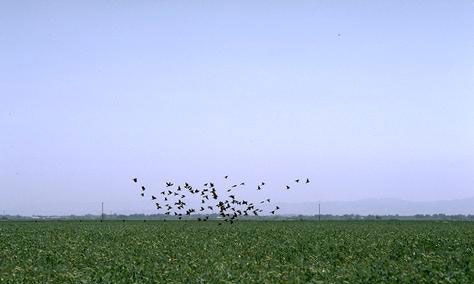
The birds, which numbered in the millions 100 years ago, are now down to about 145,000 in all. One reason for the decline, the article said, is the agricultural harvest. Before agriculture dominated the landscape, the birds nested in the valley floor's native tules, shrubs and grasses. The birds adapted to nesting in the vast fields of wheat, oats and other crops grown to feed dairy cattle. However, when the crop is harvested, many birds are caught up in the equipment, said Robert Meese, a researcher in the Department of Environmental Science and Policy at UC Davis.
The USDA is working with dairy owners to protect the young birds and some dairy operators are voluntarily delaying harvest until the baby birds can fly away, the article said.
Bees.
In San Diego, the Board of Supervisors is coming to the aid of the state's ailing bee population, said an article by Mark Walker in the San Diego Union-Tribune. The board has voted to open up county land for beekeepers who are finding it hard to place bees in areas where they can forage for nectar.
The county wants to foster more beekeeping in the face of dwindling populations from the mysterious colony collapse disorder. More hives could help honey production and farmers who need bees for their crops, the article said.
Insects.
Another insect - this one a pest - is the subject of stunning photos in a recent National Geographic feature. Photographer Sam Droege of the USGS Patuxent Wildlife Research Center captured a shot of an Asian citrus psyllid pierced by the tip of a needle that shows every tiny hair on its legs and every lens of a bulging red eye.
The article reviewed some of the research now underway to prevent the spread of huanglongbing disease of citrus, a tree killing scourge that is spread by Asian citrus psyllid. Among the possible solutions are breeding Asian citrus psyllids that can't carry the disease, genetically modifying citrus to be resident and introducing natural enemies of the pest.
One natural enemy under study at UC Riverside, Tamarixia radiata, appears in a photo that's part of the NatGeo spread. The image, by David Littschwager, shows an army of Tamarixia radiata with translucent yellow abdomens artfully back lit. The wasps were first collected in Pakistan by UC entomologist Mark Hoddle, who traveled to the Middle East to collect psyllid predators in their native range. Before being approved for biocontrol use, Tamarixia underwent a lengthy USDA evaluation intended to ensure that it wouldn't harm any native psyllids. It is now being released in ACP-infested citrus trees, where they are being carefully monitored for year-to-year survival.